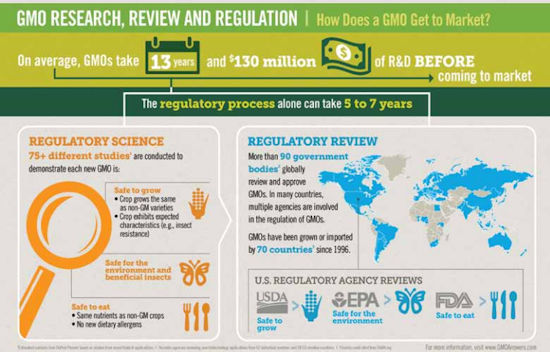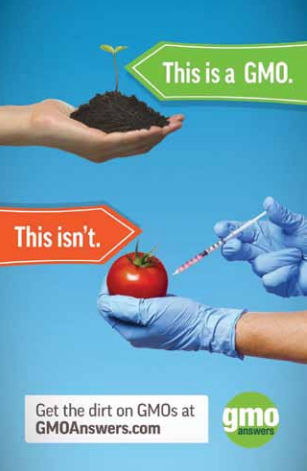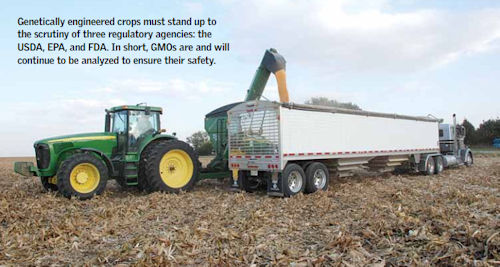How can we ensure a safe, secure, and reliable food supply? You’re standing in the cereal aisle of your favorite grocery store. Maybe you’re bored with your usual two or three cereal choices, and you want to try something new. Perhaps you’re looking for something with a little sweetness and some crunch. But it needs to be healthy: a good source of nutrients and fiber.
Armed with these criteria, you gaze at the array of colorful boxes. Right away, you see labels that may help to narrow down your choices: “honey,” “crunch,” “nutrition,” and “fiber.” You also notice words or phrases like “hearthealthy,” “natural,” and “GMO-free.”
Wait. GMO-free? Does that mean the cereals that aren’t GMO-free aren’t healthy or safe?
What are GMOs? GMO stands for “genetically modified organism.” Although practically every plant or animal-derived food we eat has been modified in some way by humans, the GMO acronym is generally used only to describe precise methods of breeding such as transgenics, where genes from another source are inserted into an organism, or RNA interference, in which targeted genes are switched off or on. (For more on what GMOs are, see “What the heck are GMOs?” in the Sept.-Oct. 2015 issue of Connections.)
There are currently just eight GMO crops commercially available in the U.S. They are corn, soybeans, cotton, canola, alfalfa, sugar beets, papaya, and squash. Two more were approved earlier this year by the FDA and will reach the market soon: Arctic apples and Innate potatoes.

What are the concerns?
According to University of Oklahoma law professor Drew Kershen, “There has not been one— not one—documented or verified claim of a human health or animal health harm from eating a GM food or GM feed.” Over 2,000 studies have been conducted showing the safety of genetic modification. Based on this evidence, over 240 organizations and scientific institutions worldwide support the safety of GMO crops.
Despite overwhelming evidence pointing to the general safety of genetically modified organisms, concerns continue to swirl around GMO foods. Adding confusion to the debate are those who profit from consumer fear and uncertainty, including food manufacturers, celebrities, and health food and supplement retailers. GMO worries tend to focus on various themes, including “lab” vs. “natural” breeding, plant-produced pesticides, weed resistance, and human and animal health effects.
“Lab” vs. “natural” breeding – Much of the suspicion focused on GMO crops has to do with the fact that the process is perceived to be unnatural. Many consumers have little understanding of how genetic modification takes place. This lack of understanding is amplified by the spread of chilling but inaccurate images depicting corn or tomatoes being injected with unknown substances. Ironically, because the GMO process takes place at the molecular level, it is actually more predictable and in many ways safer than traditional breeding.
 Plant-produced pesticides – One of the most commonly-known and widely-used GMO traits is one for insect control. Known as Bt (which stands for Bacillus thuringiensis, a naturally-occurring soil bacteria approved for use as an organic insecticide), this trait gives plants a defense mechanism against specific crop-damaging insects. When an insect such as a corn rootworm larva ingests Bt corn, insecticidal Bt protein kills the insect.
Plant-produced pesticides – One of the most commonly-known and widely-used GMO traits is one for insect control. Known as Bt (which stands for Bacillus thuringiensis, a naturally-occurring soil bacteria approved for use as an organic insecticide), this trait gives plants a defense mechanism against specific crop-damaging insects. When an insect such as a corn rootworm larva ingests Bt corn, insecticidal Bt protein kills the insect.
While it may seem logical that a protein that kills insects might also be harmful to humans, livestock, or wildlife, Bt is only effective under certain conditions. First, Bt proteins work by binding to specific proteins on the gut cell of targeted insects. These proteins are not present in the gut cells of other animals, humans, or non target insects. Also, Bt is only effective in alkaline digestive systems. Furthermore, various Bt strains are utilized, each effective only on specific insects. Finally, Bt proteins are only expressed, or located, in specific parts of bioengineered crop plants.
By way of example, a particular variety of Bt corn may express insecticidal toxins in the corn roots, which will stop rootworm feeding. But the Bt protein to control corn rootworm isn’t present in the grain consumed by livestock or people. Even if it were, humans and other mammals do not possess the proteins necessary for Bt to act, and they have acidic, not alkaline digestive systems. If people or animals did somehow consume Bt proteins, they would be simply digested with no adverse effect. Plant-produced pesticides are not limited to GMO crops. In fact, the vast majority of pesticides consumed in food already occur naturally in plants. One such pesticide, found in about 60 plant species, can kill insects that feed on the plant. This pesticide is known as caffeine.
Weed resistance – Another well-known and widely-utilized GMO trait is one for herbicide tolerance, specifically glyphosate resistance. Available in corn, soybeans, cotton, sugar beets, alfalfa, and canola, the trait for glyphosate resistance is popular because glyphosate is a safe and effective product to control weeds in those crops. (See the February 2015 issue of Connections for more information on glyphosate.) By planting seeds with the glyphosate resistance trait, farmers can control weeds in the growing crop by applying glyphosate herbicide, which will kill weeds without crop harm.
As with any method of pest control, targeted pests can develop resistance to the product designed to control it. This happens through natural selection. In the case of weeds, the few that survive glyphosate treatment lead to offspring which are increasingly tolerant of the herbicide. Applications of the herbicide then become less effective on resistant weeds.
Methods to counteract glyphosate resistance include using herbicides with varying modes of action, crop rotation, mechanical cultivation, and development of new herbicides. In the realm of genetic modification, engineering crops to contain genes for two different, independent herbicide tolerant traits can dramatically reduce the chance for weeds to develop resistance.
Health effects – According to the website GMO Answers, the number one question submitted regarding GMOs is in regards to whether they cause cancer. Dr. Kevin Folta, Professor and Chairman, University of Florida Horticultural Sciences Department, responds this way: “The short answer is no, there is absolutely zero reputable evidence that GMO foods cause cancer.” He elaborates, “Cancer is a name applied to a spectrum of diseases where cells proliferate abnormally. There is no way that the subtle and well-understood alterations of a plant’s genes can cause cancer.”
Other concerns about GMO effects on human health revolve around allergies. Registered Dietician Lisa Katic addresses this concern as follows: “No commercially available crops contain allergens that have been created by genetically engineering a seed/plant. And the rigorous testing process ensures that will never happen.” Explicit guidelines set forth by the Food and Drug Administration require scientific evidence that no potential allergens have been introduced into a GM product.
GMO safety in a nutshell
Fear of ingesting something that may be harmful is a powerful human survival mechanism. No one wants to consume foods that will make them sick. For many, the fear of developing a long-term, insidious illness like cancer or the unending health challenges of allergies are more frightening than contracting a short-term illness like food poisoning.
In the case of genetically modified organisms, the complexity of the process used to create them magnifies this basic fear. This is unfortunate, because the ways in which society has and will benefit from GMO technology are numerous—from the environmental benefits of crops requiring less insecticides to the human advantages of nutritionally-enhanced crops.
Humans and livestock have consumed genetically engineered foods and feeds extensively for more than two decades. Before and during that time, the technology has been exhaustively researched and heavily regulated. In the U.S., genetically engineered crops must stand up to the scrutiny of three regulatory agencies: the USDA, EPA, and FDA. In short, GMOs are and will continue to be analyzed to ensure their safety.
Rest assured, the breakfast cereal you choose is safe—whether it is labeled non-GMO or not.

Sources/for more information:
Genetic Literacy Project, Infographic: Climate change
vs. GMOs: Comparing the independent global scientific
consensus, http://bit.ly/1usRJWg
Forbes, The Debate About GMO Safety Is Over, Thanks
To A New Trillion-Meal Study, http://onforb.es/1mc5aaz
Biofortified, GENERA – Genetic Engineering Risk
Atlas, http://genera.biofortified.org/
GMO Answers, Are GMOs causing an increase in
allergies? http://bit.ly/1XCjaJ5; Do GMOs cause
cancer? http://bit.ly/1M00Kul; Has there ever been any
harm or illnesses caused by living near GMO fields documented
anywhere in the world? http://bit.ly/1Wkb8aw
Proc. Nat. Acad., Sci. USA, Dietary pesticides (99.99%
all natural)*, http://bit.ly/1JHXAOy
Wikipedia, Caffeine, http://bit.ly/1NG5Rmh
Article from the DeKalb County Farm Bureau’s Connections Publication
Click Here To Submit A News Tip Or Story

